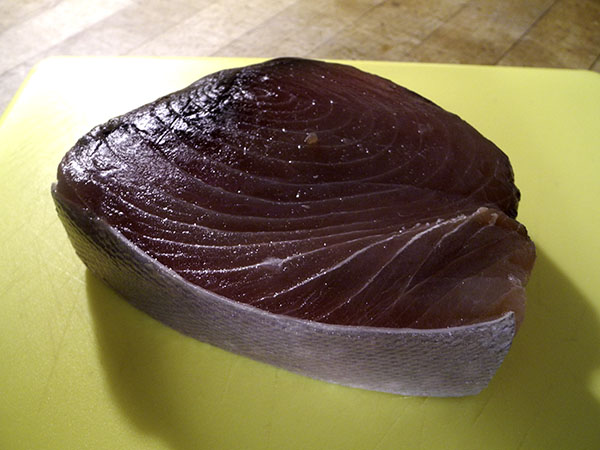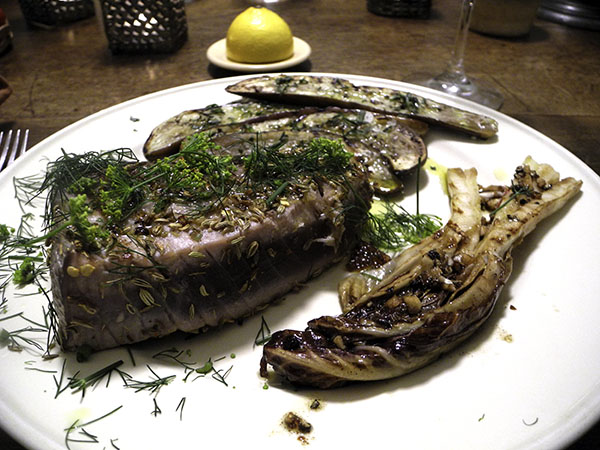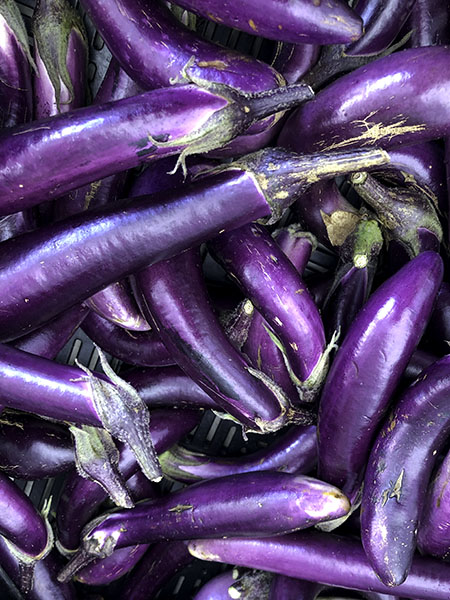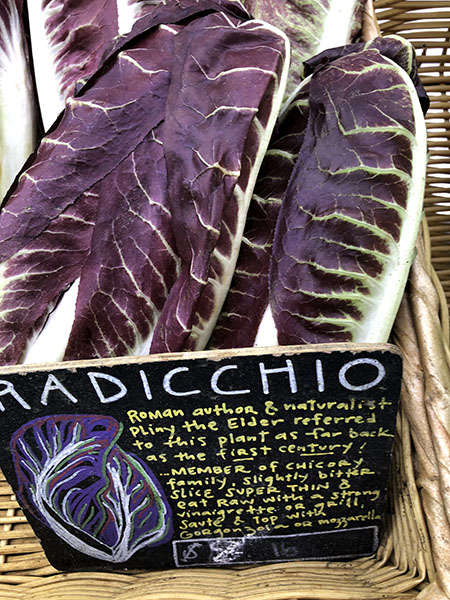
Purple.
Like the 2 vegetables, the piece of tuna loin was almost purple, but I think it would normally be described as a deep cherry red, the color, and the firmness, of raw beefsteak. Rob Williams, the fisherman from whom I had bought it that day said it was yellowfin. I’m no tuna authority, but it was so different in both appearance and taste from any tunny I have ever cooked (that number is probably something like a hundred), or eaten, that I’m inclined to think it was actually an Atlantic bluefin. The skin was also unusual, more like a light gray than the nearly black tone with which I’m familiar.
Because of the color of the flesh I was skeptical about its culinary virtues (I did say I was not an expert), so Rob cut a thin piece off of the side of the steak seen in the photo above and then handed it to me.
I tried it, savoring both the taste and the long, luxurious ‘finish’ for a couple minutes, and decided I really had to bring this treat to our table.
I was a little concerned about the area of really dark muscle, so I included all of it in my own portion, which I cut a bit larger to compensate. In the end however, I was surprised to find that it was little different from the rest of the flesh (or maybe even more tasty), so I kind of made out this time.

- one quite thick 17-ounce tuna steak from Seatuck Seafood Company’s stand in the Union Square Greenmarket, rinsed, dried, halved, tops and bottoms seasoned with sea salt and freshly-ground black pepper and rubbed with a mixture of a little more than a tablespoon of a combination of wonderful dry Sicilian fennel seed from Buon Italia and a little dried peperoncino Calabresi secchi from Buon Italia, all first crushed together in a porcelain mortar and pestle, the steaks pan-grilled above a medium-high flame on a small vintage Korean cast iron grill pan (for little more than a minute or so on each side), finished on the plates with a good squeeze of the juice of an organic lemon from Whole Foods Market and a drizzle of olive oil, garnished with flowering fennel from Lani’s Farm
Even without this very robust tuna, it would have been a very rich meal. The two vegetables I picked to accompany the tuna only just before starting the meal (the radicchio had thoughtfully survived our trip to Arkansas last week), boasted some pretty serious flavors as well.
They were also purple.
If I had taken the time to think about it, I would have tried to include more color on the plate: I even had some bright cherry tomatoes sitting right there on the breakfast room windowsill.

- five small Japanese eggplant from Betsy Ryder’s family ancestral (since 1795) Ryder Farm, each halved lengthwise, brushed all over with a mixture of a little olive oil, 2 finely-chopped medium size rocambole garlic cloves from Keith’s Farm, a pinch of super-pungent dried Sicilian oregano from Buon Italia, sea salt, and freshly-ground black pepper, pan-grilled on an enameled cast iron ribbed pan above a brisk flame, turning twice, adding more of the material from the marinade the second time, then arranged on the plates, sprinkled with chopped winter savory from Keith’s Farm, and drizzled with a bit of olive oil

- the remains of one small head of treviso, including its stem, which was the length of the the leaf section attached above it, from Tamarack Hollow Farm in the union Square Greenmarket (the outer leaves had gradually been pulled off and used in earlier meals) halved lengthwise, the stem sliced through several times to speed its cooking evenly, marinated for half an hour in a mix of one medium finely-chopped Keith’s Farm rocambole garlic clove, a small bit of balsamic vinegar, olive oil, sea salt and freshly-ground black pepper, pan-grilled, then finished on the plates with some of the reserved marinade
- the wine was a Portuguese (Douro) white, Crasto White 2016, from Garnet Wines
- the music was Sebastian Fagerlund’s opera, ‘Höstsonaten (Autumn Sonata), inspired by Ingmar Bergman’s 1978 chamber drama Höstsonaten (Autumn Sonata), John Storgårds conducting the Finnish National Opera Orchestra